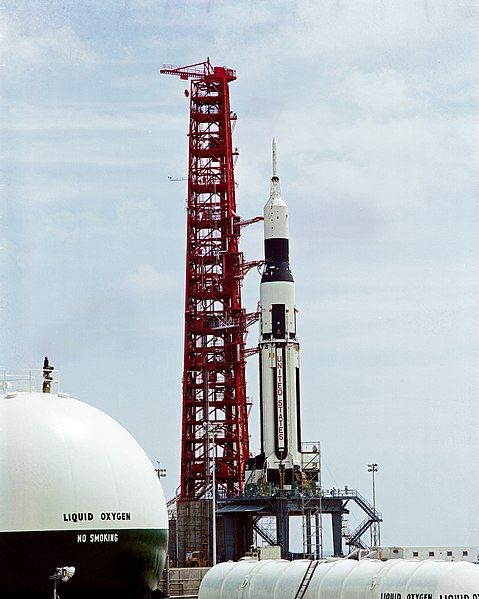AS-101 was the sixth flight of the Saturn I launch vehicle, which carried the first boilerplate Apollo spacecraft into low Earth orbit. The test took place on May 28, 1964, lasting for four orbits. The spacecraft and its upper stage completed a total of 54 orbits before reentering the atmosphere and crashing in the Pacific Ocean on June 1, 1964.
AS-101 (SA-6)
George Mueller, Wernher von Braun, and Eberhard Rees (MSFC Director for Research and Development) watch the AS-101 launch from the firing room.
The Saturn I was a rocket designed as the United States' first medium lift launch vehicle for up to 20,000-pound (9,100 kg) low Earth orbit payloads. The rocket's first stage was built as a cluster of propellant tanks engineered from older rocket tank designs, leading critics to jokingly refer to it as "Cluster's Last Stand". Its development was taken over from the Advanced Research Projects Agency (ARPA) in 1958 by the newly formed civilian NASA. Its design proved sound and flexible. It was successful in initiating the development of liquid hydrogen-fueled rocket propulsion, launching the Pegasus satellites, and flight verification of the Apollo command and service module launch phase aerodynamics. Ten Saturn I rockets were flown before it was replaced by the heavy lift derivative Saturn IB, which used a larger, higher total impulse second stage and an improved guidance and control system. It also led the way to development of the super-heavy lift Saturn V which carried the first men to landings on the Moon in the Apollo program.

The first Saturn I was launched October 27, 1961.
A 1/20th-scale model of first-stage Saturn is prepared for testing in the 16-foot transonic wind tunnel at Arnold Air Force Base in the early 1960s
Von Braun, with JFK pointing at Saturn I at Cape Canaveral on 16 November 1963, weeks prior to its launch
Diagram of the S-I first stage of the Saturn I






